Free February Desktop Calendar
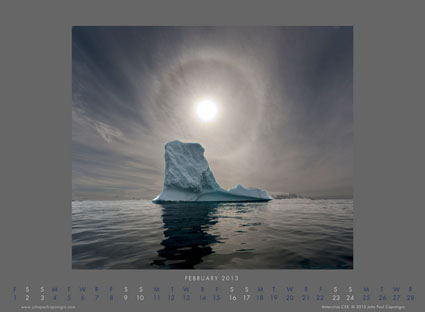
My free February desktop calendar features an image from Antarctica.
Download it here now.
Find out about upcoming events here.

My free February desktop calendar features an image from Antarctica.
Download it here now.
Find out about upcoming events here.
Antarctica LIV, Plenneau Bay 2007
In 2007 I visited Plenneau Bay, Antarctica, which lies just past the famous La Mer Channel. This was the only Zodiac cruise where all the workshop leaders (Michael Reichmann, Jeff Schewe, Stephen Johnson, Bill Atkinson, Ian Lyons, Seth Resnick and I) rode together while Chris Sanderson recorded the event on video for Luminous Landscape. Locked out of this area by ice in 2005, we were delighted to have access to the area many people call ‘The Iceberg Graveyard” because the shallow bay frequently traps ice.
We found a floating sculpture garden made of ice in a stunning array of forms. We found frozen sea creatures, both real and mythical. We found Viking ships and space ships. We found pyramids and grottos. One iceberg impressed us above all the others. We first approached it from one side hoping to glide across the pool of water in its center and through an arch on the far side, but we discovered the arch was too shallow to pass through. Double backing, we then approached it from the opposite side. We gasped collectively when we saw what another angle had to offer. The ice had been sculpted in what appeared to be a Grecco-Roman façade complete with a central arch and accompanying rhythmically repeating columns. To this day we still have a hard time believing that this was a naturally occurring form and not man-made. This was one of those unforgettable moments that changes the way you see and think about the world as you become aware of possibilities you hadn’t previously dreamed of.
Despite the rich subject matter, it was challenging photographically, as we had hours in an area we could have spent days and consequently moved through it rapidly, which forced us to work like action photographers. At one point in our magical voyage, I teased Michael that he was encouraging very bad habits – shoot first, ask questions later. But I made the best of it knowing that I would never see this again and while I was doing so I realized that this push outside of my contemplative comfort zone would encourage me to acquire skills that would prove useful in other situations. They have been useful in many other unforgettable moments.
Which mode are you most comfortable in?
How can switching between contemplative to active modes help you?
Find out more related images here.
Read more The Stories Behind The Images here.
Learn more about Antarctica here.
Discover my Antarctica workshops here.
Every voyage I’ve made to Antarctica has revealed new dimensions in the subject – weather, light, seasonal changes, annual variations, and my growing understanding of the region have all contributed to this.
With so many wonderful places to go, why would you return to the same location more than once?
Let me count the ways.
1 You’ll see more of and learn more about a place.
Increase your understanding of the places you photograph and your photographs will become more interesting.
2 You’ll have an opportunity to get the images you missed.
Try making a shortlist of the shots you missed when you shoot. Even if you never return this activity will prompt you to be clearer about why you missed the shots and you can take steps towards remedying this in the future. If you do return, you’ll have the beginnings of a working plan that will greatly increase your productivity and success rate.
3 You’ll have an opportunity to refine the images you made.
You may have made images that barely made the cut but would shine if they were reframed or made with different equipment or in different conditions. For this reason, I recommend you review not only the images that worked on your previous trip(s) but also the ones that didn’t asking yourself why they didn’t and what you could do differently.
4 You’ll see new things as your vision matures.
Having first found the images that come to you more naturally, you’ll later find yourself challenged to look for other kinds of images, which will stimulate your creativity and increase your visual versatility.
5 You’ll see changes in the place.
Time reveals. Weather, time of day, seasons, and the accumulation of years change a place. They change us too. These changes can become a wellspring for many images.
6 You’ll learn more about yourself.
While it’s true that you can learn more about yourself when you experience new things, it’s equally true that you’ll learn more about yourself when you re-experience them. You’ll find that your relationship with a location will change over time, as you experience more and mature. You’ll see not only how a place has changed but also how you’ve changed – and how the place has contributed to your growth. These types of insights are harder to achieve in new locations. Because the perspective with which you look at thing is different, the types of things you learn are different.
7 You’ll get to spend more time in your favorite places.
Just as you can’t go everywhere, you can’t return to every place. Return to the places that call you. Passion kindles the fires within, which will be visible in your images. Passion energizes and recharges us. A large part of the reason we do the things we do is because we enjoy them.
Unfamiliar locations challenge you to see new things in new ways, familiar locations challenge you to see the same things in new ways.
Just because we see new things doesn’t mean we will see in new ways, in fact the times when we are grappling with so many new variables are often the times when we fall back on our habits. When we see the same things again we are forced to see in new ways and/or deepen the ways we see them.
Even with a lifetime of adventuring, you can’t see it all. Your question is do you want to see a lot or do you want to see deeply? You’ll want to strike a balance between the two, surveying the many opportunities before you and choosing to return to one or a few of the places that call you the most. Exactly what balance you strike at any given moment is up to you.
Learn more in my Storytelling resources.
Learn more in my creativity and digital photography workshops.
No other photographer is more influential to me than Eliot Porter – save my father. I knew Eliot through my mother’s long collaboration with him designing and overseeing the production of over twelve of his books during my formative years. His influences on me are too numerous and wide-ranging to list them all here. A few stand out from the rest.
Eliot was a pioneer who elevated the use of, appreciation of, and collectability of color within the medium of photography, aligning his distinctive style with the subtle and complex palette of nature.
Eliot was probably the most widely published fine art photographer of his day. He was at the forefront of a handful of photographers that defined a style that would later characterize an entire genre of photographic environmental advocacy. It was during the production of Eliot’s book Intimate Landscapes where I was first introduced to digital imaging. When I saw the Scitex machines used in the 1970s I instantly wanted to use them for artistic rather than commercial purposes, but thought it might be a lifetime before I could afford what my mother called a “million dollar coloring book” until I got my own copy of the first version of Adobe Photoshop, which was a dream come true. The posters my mother designed to promote the book and exhibit ultimately became some of the Metropolitan Museum’s most successful, far exceeding the reach of the originals. I learned that an artist’s effectiveness could be dramatically extended beyond rare original works of art through publications made available to large audiences.
James Gleick’s (the author who popularized complexity sciences and fractal geometry in his best-selling book Chaos) choice to join forces with Eliot on their book Nature’s Chaos confirmed my opinion that Eliot had intuitively sensed a deeper order in nature than was conventionally seen and portrayed this in his images. Eliot’s background and continuing interest in the sciences informed his art.
Eliot described his book The Place No One Knew, a portrait of Glen Canyon before it was flooded by a dam, as a eulogy because it was released after the floodwaters began rising and affected public opinion too late to stop the destruction of the canyon’s destruction. Hearing about both the successes and failures of advocacy through the arts, I decided that while I wanted to make my own contributions in this area, there were plenty of other artists contributing in similar ways and new ways were also needed. He knew this when he threw down the gauntlet one day and said to me, “You know, it’s going to be your generation that decides whether we will hand down a habitable environment to future generations.”
Even more influential to me than his photographs was the man. In his 70’s and 80’s, Eliot was physically fit (walking 5 miles a day), adventurous (traveling to remote locations like Iceland and Antarctica), mentally sharp as a tack (loving intelligent respectful debates with anyone of any age or background and often playing the devil’s advocate just to see where the conversation and the other person would go), and actively socially conscientious (continuing his long-standing participation in organizations like the Sierra Club. He was a shining example in so many ways.
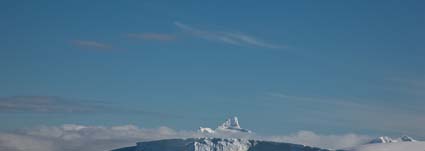
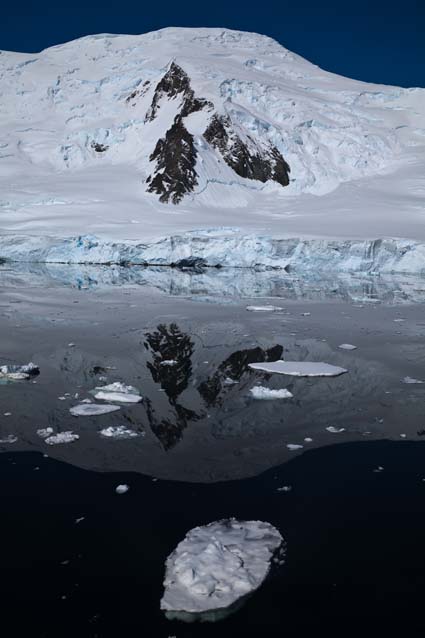
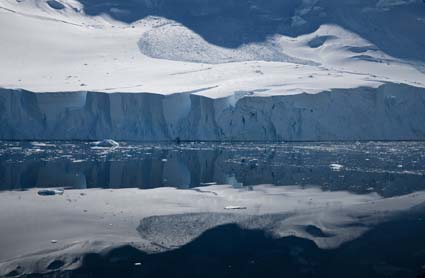
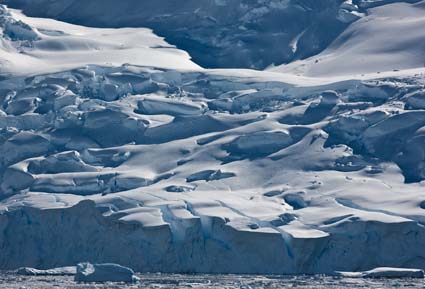
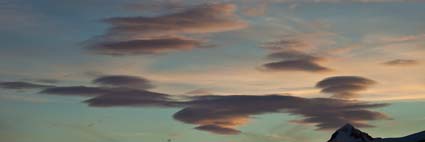
People keep asking Seth Resnick and I why we keep returning to Antarctica.
We’ve made four trips and every trip was different. We visit new locations; there are over 40 locations cruises land at and with each visit we get to visit an average of 12. The ice conditions are always different; one month can make a big difference. Surprisingly, the thing that we’ve found makes the biggest difference is the weather, which affects the light dramatically. We saw riotous colors during four hour long sunsets on our 2005 Peninsula trip and “nights” where the sun only skims the horizon but never truly sets south of the Antarctic circle in 2009. Every time we go, we keep wondering how much more could there be to see and how different could the conditions be and every time we’re surprised that we discover so much more and that locations we know look so different. Each voyage has had an entirely unique character.
The two most sublime landscape experiences I’ve ever had were at Sossusvlei, Namibia and in Antarctica’s The Gullet. The Gullet was the remotest, purest, whitest experience I’ve ever had. It felt like being in a frozen heaven. Quietly cruising on mirror calm waters through the dramatic mountains of Crystal Bay to find the narrow channel through The Gullet (like seeing clouds cascade off high peaks to touch the water and be frozen in place) and through to Margueritte Bay lit up by endless hours of midnight color was one of the most beautiful 24 hours of my life. Many of us didn’t sleep that ‘night’ because we didn’t want to miss anything. We knew while we were there that few people on earth had ever had an experience similar to the one we were having.”
See more images from Antarctica’s The Gullet here.
There are still a few spaces available in our Antarctica 2013 workshop.
Email me at jpc@digitalphotodestinations if you’d like to join us.
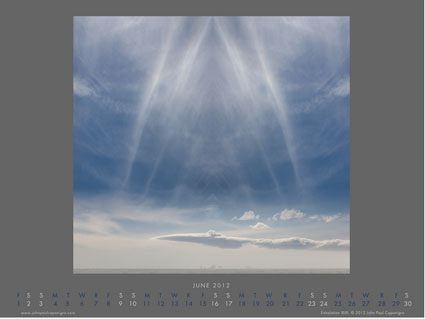
My free monthly desktop calendar for June features an image from Antarctica.
Download it here.
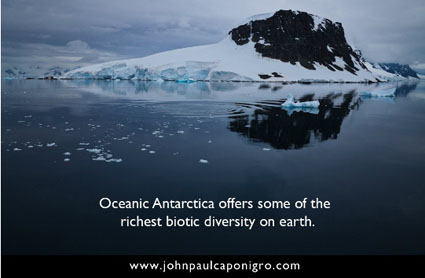
My new free screensaver features images and facts on Antarctica.
Download it here.
Antarctica is stunningly beautiful! Explorer Roald Amundsen said, “The land looks like a fairytale.” The coldest, windiest, driest, highest, most isolated continent contains 90% of earth’s ice and 70% of its fresh water, regulating global climate and sea levels.
Learn more about Antarctica here.
Preview my book Antarctica here.
View my Antarctica alumni’s work here.
Find out about my 2013 Antarctica workshop in the Wedell Sea.
I’ll be presenting a free lecture sponsored by Canon tonight at 7pm hosted by the Black Hills State University in Spearfish, South Dakota.
In this two hour event I’ll present a set of separate lectures including an extended version of my TED talk You’re More Creative Than You Think You Are (above).
Find out more about the event here.
Learn more in my workshop Illuminating Creativity.
[slideshow]
Discover fascinating facts about Antarctica.
Furthest south, coldest, windiest, highest, most isolated continent barely begins to describe this exotic region.
Find more Antarctica facts here.
Find out about my Antarctica digital photography workshops here.